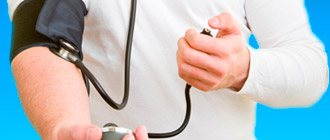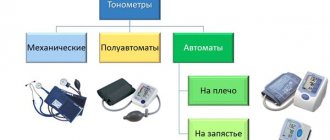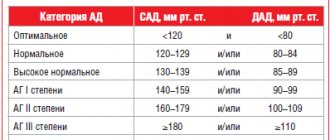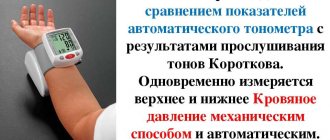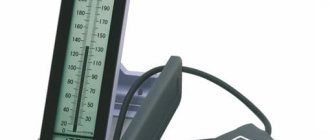What pressure is considered the most normal?
Normal blood pressure is 100-139 mm Hg. Art. If systolic pressure drops below 90 mm, hypotension occurs.
This condition is potentially not dangerous, but can create a strong feeling of discomfort. The most unpleasant thing about hypotension is a significant decrease in concentration. A person faced with such an illness will find it difficult to even read. If systolic pressure exceeds 140 mm, hypertension is recorded.
Why does the lower pressure change?
An increase in lower pressure may be associated with:
- Narrowing of the lumen in the renal arteries, their increased tone;
- Kidney diseases;
- Significant excess weight;
- Myocardial dysfunction;
- Diabetes mellitus;
- Changes in the concentration of hormones in the blood.
When diastolic pressure deviates from the norm, a person feels a loss of strength, chills in the lower extremities, and drowsiness. A nagging headache appears, sweating increases, concentration decreases and memory deteriorates. Possible discomfort in the heart area, arrhythmia. This is why it is important to measure your blood pressure regularly so that if there are any abnormalities, you can immediately consult a doctor.
What are the symptoms of hypertension
High blood pressure can cause great harm to the human body. Often it indicates the presence of pathologies. This phenomenon occurs due to high vascular resistance. But this is only one of the possible options. Only an experienced doctor can give accurate information. It is important to take into account that the state of blood pressure can be influenced by overwork, the use of special medications, and the inclusion in the diet of food containing substances that affect blood pressure.
In medicine, there are several conditions of blood pressure:
- normal;
- high;
- hypertension 1 degree;
- hypertension 2 degrees;
- hypertension 3 degrees.
Note that grade 3 hypertension is registered when the level reaches 180/110 mmHg. Art. A large number of different studies have been conducted regarding arterial hypertension, but they have not been able to identify the exact causes of the development of hypertension.
Consequences of blood pressure disorders
Functional disorders of the heart, kidneys, excess weight, stress, smoking, endocrine and systemic diseases, and atherosclerotic changes in blood vessels lead to a prolonged increase in blood pressure levels. For most people, initial deviations do not cause alarm, but are dangerous for the body. Progressive hypertension is fraught with the development of coronary artery disease, myocardial infarction, and acute cerebrovascular accident.
Regular hypotension - readings below 85/60 lead to insufficient oxygen and nutrition to the tissues. This pathology often occurs due to heart failure, physical exhaustion, and genetic predisposition. Without correction, it can provoke disruption of the central nervous system, hormonal balance, anemia and myocardiopathy.
What reasons can cause high blood pressure
Medicine has established the most common causes that can cause high blood pressure in the human body. These include influencing factors such as drugs, diseases of the urinary system, endocrine diseases, aortic diseases, complications arising during pregnancy, problems with the nervous system.
Antidepressants and glucocorticosteroids (for example, prednisolone) can cause high blood pressure. Contraceptives can also have a negative impact. Risk factors that can lead to the development of hypertension include the following:
- Hereditary factors.
- Prematurity.
- A child's low weight may indicate a potential predisposition to high blood pressure.
- Large overweight.
- High salt content in food. The norm for table salt consumption is considered to be 5 grams per day.
- Drinking alcohol, smoking. Bad habits can worsen the condition of blood vessels and affect the circulatory system in the most detrimental way.
- Insufficient physical activity.
- Poor environment, daily stress, increased noise levels.
Of all these factors, it is necessary to focus a lot of attention on excess weight, bad habits, and severe stress. In most cases, these reasons increase the risk of hypertension.
from May 14 to 24 as part of the Year of the Heart at the City Hospital No. 1
them. G.I. Drobyshev hosts an informational and practical campaign
“Learn to control your blood pressure.”
One of the most common health complaints and one of the most “favorite” diseases among older people is increased blood pressure. This pathology can explain any changes in well-being, bad mood and other troubles. Blood pressure can rise and fall several times during one day, and a person’s normal blood pressure is a purely individual concept.
What is blood pressure and what indicators are considered normal?
Blood pressure is a general concept that determines the force with which blood presses on the walls of blood vessels; it would be more correct to call it blood pressure, because pressure matters not only in the arteries, but also in the veins and capillaries. But it is only possible to measure pressure in large vessels located on the surface of the body—in the arteries—without the help of special instruments.
Blood pressure - blood pressure - depends on the speed and force with which a person’s heart contracts, how much blood it can pump in one minute, on the properties of the blood itself and the resistance of the walls of blood vessels.
Factors influencing blood pressure:
- the ability of the heart to contract with sufficient force and ensure normal release of blood through the vessels;
- from the rheological properties of the blood - the “thicker” the blood, the more difficult it is to move through the vessels; diseases such as diabetes mellitus, increased coagulability, greatly impede the flow of blood and can lead to problems with blood pressure; with thick blood, some doctors prescribe treatment with leeches;
- elasticity of the walls of blood vessels - blood vessels wear out over time and cannot withstand increased load - this becomes the cause of the development of hypertension in older people,
- atherosclerotic changes - reduce the elasticity of the walls;
- sharp narrowing or dilation of blood vessels - as a result of nervous shocks or hormonal changes, a sharp narrowing or dilation of blood vessels is possible - for example, with fear, anger or other strong emotions;
- diseases of the endocrine glands.
Normal blood pressure is determined by a combination of a large number of parameters, and for each age, gender and for an individual person, its indicators can vary greatly. Medical standards are taken as average values from healthy people of a certain age. It has long been proven that blood pressure of 120/80 cannot and should not be considered the ideal norm for people of different ages.
To find out what normal blood pressure a person should have at different age periods, you can use the following table.
Blood pressure indicators for an adult:
- Normal blood pressure is considered to be between 110\70 and 130\85 mm. rt. Art.
- Low normal pressure – 110\70 – 100\60;
- Low blood pressure – hypotension – below 100\60;
- Increased normal pressure – 130\85-139\89;
- High blood pressure - hypertension - more than 140\90 mm. rt. Art.
Indicators of normal blood pressure for different age periods:
- 16 – 20 years – 100\70 – 120\80 mm. rt. Art.
- 20 – 40 years – 120\70-130\80;
- 40 -60 – up to 140\90;
- over 60 years old – up to 150\90 mm. rt. Art.
From the table above, it is clear that the older a person is, the higher the normal blood pressure indicators; this is due to age-related changes in blood vessels, in the heart muscle and in other organs. High blood pressure, like low blood pressure, can cause various health problems, but in order to determine whether changes in blood pressure are to blame for poor health, you need to measure it regularly and keep a special diary. For this, several trips to the clinic or visits to the doctor are not enough; only daily regular blood pressure measurements can give correct results.
Measurement.
The correct diagnosis and prescription of treatment largely depends on the correct measurement of blood pressure, because the doctor, when prescribing medicine or prescribing treatment, is largely guided by the measurement numbers.
Today there are different ways to measure pressure:
- The simplest and oldest - using a cuff and a tonometer - here it is of great importance to correctly apply the cuff, the ability to use a tonometer and listen to heart sounds. This measurement requires special training and skills, but when used correctly, it gives fairly accurate and reliable results.
- Electrotonometer - the operating principle is the same, but the results are visible on a special display. This makes it easier to measure your blood pressure yourself and provides more accurate results. But such blood pressure monitors often break down and may show incorrect numbers.
Regardless of the method used to measure blood pressure, several general rules must be followed:
- before the measurement, half an hour before the start, avoid physical activity, nervous tension, smoking, eating, and so on,
- relax, sit comfortably when measuring,
- the posture should be comfortable, the back should be straight, there must be support, the hand should rest freely at the level of the patient’s chest,
- you cannot talk or move during the measurement,
- The measurement should be carried out on both hands and it is advisable to carry out a series of measurements with an interval of 5-10 minutes.
If, after correctly measuring blood pressure, the readings are very different from the norm, you need to repeat the measurements within a few days and, if confirmed, consult a doctor.
High blood pressure.
Considered one of the most dangerous diseases of mankind, hypertension affects about 25% of people worldwide, and this figure continues to increase. Hypertension is an increase in blood pressure above 140/90 mmHg. rt. Art. Causes of hypertension can be:
- overweight,
- genetic predisposition,
- diseases of internal organs,
- lack of physical activity,
- smoking and drinking alcohol,
- excessive consumption of table salt,
- nervous tension,
- other factors.
With hypertension, the patient suffers from headaches (and here pills for headaches will not help), shortness of breath, heart pain, increased fatigue, insomnia, poor health and other symptoms. In addition, the risk of developing cardiovascular diseases, brain damage, pathology of the urinary system and eye diseases increases.
Treatment of hypertension is a very complex and time-consuming process, where the outcome of the disease depends on compliance with the doctor’s recommendations. It is important to find the cause of the increase in pressure and act on it. At the same time providing symptomatic treatment. In each specific case, medications, doses and their combinations must be selected individually by the attending physician.
Without timely treatment or uncontrolled use of medications, hypertension can not only seriously damage health, but also cause a life-threatening condition such as hypertensive crisis.
Hypertensive crisis.
Hypertensive crisis is a life-threatening condition caused by a sharp increase in blood pressure and damage to the nervous system and target organs. Blood pressure figures during a hypertensive crisis can vary greatly in different patients - some people normally tolerate 200\150 mm. rt. st, and for some people feel bad already at 150\85 mm. rt. Art. The nature of the lesions in GC depends on which organs previously had the pathology - if the heart hurts, myocardial infarction may occur, if you suffer from headaches, then a stroke, and so on.
The causes of GC may be:
- psycho-emotional stress,
- exercise stress,
- meteorological changes,
- drinking alcohol,
- rich foods high in salt,
- incorrectly selected antihypertensive drugs,
- diseases of the endocrine system and internal organs.
With the development of GC, the patient’s well-being sharply worsens, a feeling of fear and anxiety arises, nausea, vomiting, darkness before the eyes, swelling and flushing of the face, chills, tremors of the limbs, fainting, and even coma may appear.
If such symptoms appear, you need to lay the patient on any flat surface with the head of the bed raised and immediately call an ambulance. Before her arrival, try to provide the patient with peace, an influx of fresh air, and get rid of restrictive clothing. If the patient has had hypertension for a long time, then, most likely, he is taking some kind of antihypertensive drug, in this case, before the doctor arrives, you can give the patient the usual dosage.
Hypotension, low blood pressure.
For many people, especially those suffering from hypertension, it seems that lowering blood pressure cannot be a problem, but in fact this is not the case. Constantly low blood pressure can cause no less inconvenience and health problems than hypertension.
The causes of this pathology can be hereditary predisposition, poor nutrition and vitamin deficiency, endocrine diseases, nervous strain, general exhaustion of the body and other problems.
A person suffering from hypotension constantly feels tired, overwhelmed, has difficulty performing daily duties and is emotionally inhibited. In addition, there is a decrease in memory and brain activity, poor thermoregulation, increased sweating, headaches, drowsiness, pain in the joints and muscles, and a general feeling of poor health.
Although, unlike hypertension, hypotension does not cause serious health problems, it also requires treatment. Only a doctor can determine the cause of hypotension and prescribe treatment after a detailed examination. And without medical help, we can advise you to establish a work and rest schedule, eat well, not be nervous and give up bad habits.
Original article https://tibet-medicine.ru/sovrmed/normalnoe-davlenie-cheloveka
What pressure is considered critical?
We noted that the highest pressure in the world was 310/220 mm Hg. Art. However, doctors say that 260/160 mm Hg is considered critical indicators. Art. Thus, the record blood pressure can be considered a phenomenon, because even at critical values the human body can die.
The occurrence of hypertension can lead to hypoxia, the greatest harm of which is the negative impact on the brain, which is actually deprived of oxygen. The problem with the brain lies in its seemingly unusually developed blood supply system. The vascular ring can work normally only at normal pressure values. Otherwise, tone regulation is disrupted, permeability increases, and then hypoxia may develop.
What does systolic blood pressure indicate?
Any deviations of indicators from the norm indicate malfunctions in the functioning of one or another body system. Both values or only one of them can increase or decrease. For example, an increase in systolic pressure occurs when:
- Overactive thyroid gland – thyrotoxicosis, when the thyroid gland secretes too many hormones;
- Severe anemia, when the type of blood circulation changes;
- Slowing of the pulse - bradycardia, ineffective operation of the aortic valve, when the upper pressure increases due to increased blood release;
- A decrease in the elasticity of the aorta, an increase in the density of its walls - most often the cause is atherosclerosis of a large vessel in old age.
An increase in only the upper pressure without changes in the lower is called systolic arterial hypertension. But such a deviation does not always indicate a disease. So, with significant sports loads, an increase in upper pressure is also observed, and this is not considered a deviation from the norm.
What is the prevention of high blood pressure?
People who experience high blood pressure need to remember the need for regular checks. Often a person does not feel symptoms and does not suspect what danger blood pressure hides. Even with long-term hypertension, people ignore the condition, attributing everything to fatigue or overwork. It is important to understand that pressure increases when blood vessels narrow, when the heart has to work at “high speed.”
Foods containing large amounts of saturated fatty acids can lead to hypertension. The highest content of these substances is found in butter, cheeses, and sour cream. It is recommended to avoid products containing large amounts of palm oil. Cake, chocolate, cookies, fatty sausage, chips are all sources of saturated fatty acids. Of course, it is important to take into account physical activity; you need to eat exactly as much as the body needs to ensure normal functioning. Moreover, you need to take into account the composition of the products. Many manufacturers even indicate the percentage of EFA content per 100 grams.
The amount of salt consumed also needs to be reduced. Scientists have long noticed the effect it can have on the human body when consumed excessively. The biggest problem is that most foods sold on supermarket shelves contain quite a bit of salt. By using this additive in our diet, we expose our body to even more danger. For those who love salty foods, the best option to get rid of excess is physical activity. Salt can reduce the elasticity of blood vessels and negatively affect the kidneys and liver.
Changes in blood pressure by age
It is a mistake to think that blood pressure control is only necessary for older people. Diseases associated with its violation can develop at any age. In order not to miss them, it is recommended to monitor blood pressure levels regularly from the first years of life. At the same time, it is important to remember that its standards are different for children and adults. Their range:
- in newborns: from 75/50 to 105/75
- aged 1–5 years: from 80/55 to 110/79
- for 6–15 year olds: from 90/60 to 110/80
- for 16–24 years old: from 110/70 to 132/80
- for 25–39 years: from 110/70 to 135/86
- for 40–59 years: from 111/78 to 139/88
- for 60 years and older: from 116/80 to 147/90
Low rates in infants and children under 1 year of age are explained by imperfections in the vascular system. Their arteries are not elastic enough, and the network of capillaries is dense. As you grow older, the body's tone increases, and the range of blood pressure fluctuations becomes smaller. In children over 5 years of age, blood pressure increases more slowly, reaching the lower limit of the adult normal range by adolescence.
During school years, due to sharp jumps in growth and development, more frequent changes in indicators are possible, including throughout the day. If the condition is not accompanied by poor health, there is no need to worry. An increase of 20 mm or more should cause alarm. In these cases, correction of the daily routine and consultation with a therapist, endocrinologist and cardiologist are required.
Another category of people in whom significant changes in blood pressure are considered normal are pregnant women. Changes in hormonal levels and increased workload inevitably affect the functioning of blood vessels and internal organs. During this period, indicators should be monitored regularly. Their departure from the age norm is a reason for additional consultations with a doctor.
What effect does alcohol have?
Many people believe that drinking alcohol helps lower blood pressure. However, here it is necessary to remember that we are talking about vasodilation, which does not necessarily play a positive role. Alcohol should be consumed in moderation.
Regular drinking of alcoholic beverages, even in small quantities, can increase blood pressure. You should also remember about the biologically active substances contained in many alcoholic beverages. Energy drinks pose a high risk to the human body. Combining them with alcohol can lead to the most harmful consequences.
What to do during a hypertensive crisis (HC)
If your blood pressure reaches a critical level, you must immediately call an ambulance.
In case of uncomplicated HA, this pressure should be reduced very slowly, every 2 hours up to 25%.
With a rapid decrease in blood pressure, hypoperfusion may develop - impaired circulation in tissues/organs . Before the ambulance arrives, you can put Nifedipine or Capoten under the patient’s tongue so as not to aggravate his condition.
Complicated HA threatens with fatal complications: stroke, pulmonary edema, etc. This condition is especially dangerous in pregnant women. In this case, parenteral administration of drugs and urgent hospitalization are necessary to reduce pressure, the decision about which is made by the ambulance team called.
What measures should be taken to control blood pressure
In fact, the simplest measures can help protect the body from many problems. You need to eat food that contains a minimum of salt, stop smoking, play sports - even moderate physical activity will help the body be in good shape, which will have a beneficial effect on the condition of the circulatory system.
It is important to minimize stressors and avoid irritants. Constantly monitoring your blood pressure is also a good habit. Under no circumstances should you take medications without a doctor’s prescription.
Much attention should be paid to the issue of stress. With daily negative psychological impact, a person must compensate for stress with physical activity. It has been proven that with physical activity, cortisol levels are significantly reduced. Training should be regular, as it allows the body to enter a certain mode and maintain it. The intensity doesn't have to be high.
What does the change in indicators depend on?
The permissible minimum difference between the upper and lower values, as well as the normal blood pressure for people depending on age, will be described below. But the reasons for the jumps in these numbers can be various reasons. As a result of numerous studies, it has been proven that the standard of living, external factors and health status in general affect the results of blood pressure assessment.
If for one person an increase in indicators by 10–20 units is considered normal, then for another it can turn into a disaster.
In 90% of cases, overestimation of blood pressure is recorded in obese people, and age also affects blood pressure levels. In an elderly person, blood vessels lose their former elasticity, and the body as a whole and the cardiovascular system in particular undergo age-related changes - as a result, blood pressure increases. However, over the past decades, signs of persistent hypertension have also been observed in very young people aged 30–35 years.
No ads 2
The following factors influence this:
- nature of the diet;
- bad habits (smoking and alcohol abuse);
- lack of proper rest;
- excessive brain and physical activity, leading to exhaustion of the body;
- emotional overload and frequent stressful situations.
If the pressure is increased by 10–20 units after intense physical activity (sports, carrying heavy weights), this is absolutely normal and, after a while, the indicators will return to the initial values on their own. Blood pressure is usually reduced during sleep and immediately after waking up, since the body is in a state of rest and relaxation.
Completing all vital processes, before going to bed, the body also reacts with a jump in blood pressure by 10–20 units. Low blood pressure occurs in women during the menstrual cycle, during pregnancy, and in men during colds.
What device is used to record pressure?
To monitor the blood pressure, a tonometer is used. There are automatic and semi-automatic devices. There are also mechanical ones. They use a rubber bulb. Despite the widespread use of automatic and semi-automatic tonometers, doctors resort to mechanical analogues, as they allow them to obtain the most accurate information. This involves using a phonendoscope to listen to the contraction of the arteries.
Which blood pressure monitor should you buy? This will depend on the frequency of use. If you plan to use the device infrequently, you can select the automatic (semi-automatic option). This device has the option of saving measurements, a timer, a convenient display showing indicators, a calendar and various technologies. However, it will have to be calibrated regularly, batteries will need to be changed, and the service life is relatively short. If you need to use a tonometer every day, it is better to purchase a mechanical analogue. Of course, it is not so comfortable, but it is practical. There are enough manufacturers on the market producing various tonometers. Among them are Rossmax, A&D, Microlife, Omron. Many semi-automatic and automatic models are reliable, although quite expensive. However, they can help to correctly interpret the indicators and even prevent dangerous consequences.
Ways to lower blood pressure permanently
In the initial stages of hypertension, the first step is to prescribe therapy with non-drug methods associated with changing the patient’s lifestyle:
- To give up smoking. Tobacco smoking is recognized as one of the main risk factors for the development of arterial hypertension. One cigarette smoked leads to a sharp increase in blood pressure and increased heart rate.
- Normalization of body weight. Numerous studies have proven that losing weight in overweight or obese patients leads to stabilization of blood pressure.
- Increasing physical activity. Regular dynamic physical exercises in the air for 50-40 minutes at least 4 times a week are recommended.
- Reducing salt intake to 5 g/day.
- Limit alcohol consumption.
- Compliance with the work and rest regime.
- Balanced diet. Increasing the proportion of plant foods and low-fat dairy products in the diet.
While blood pressure is slightly elevated, following the principles of a healthy lifestyle can stabilize blood pressure at a normal level with minimal drug support or even without drugs at all.
As the disease progresses, hypertension is treated using medications from various pharmacological groups to achieve a reduction in blood pressure to normal levels.
First aid at home for symptoms of high blood pressure:
- It is necessary to reassure the patient and create conditions for physical and emotional peace.
- Provide a flow of fresh air into the room.
- Breathing exercises help to quickly reduce pressure: take a deep breath, hold your breath for 10 seconds, exhale noisily through your mouth, then take short breaths in and out through your mouth for 2 minutes.
- Give the patient Corvalol to drink: dissolve 30 drops in 100 ml of water.
If attacks recur repeatedly, you should consult a doctor to find out the cause of the increase in pressure.
Hypertension and hypotension, low blood pressure, symptoms, diet, treatment
These diseases have a common pedigree and causes, a common prevention, but different consequences from the destructive action and completely opposite methods of treatment. What do you need to remember to avoid complications?
Causes of increased and decreased pressure
If the sympathetic centers of the autonomic nervous system are excited, the pressure rises, if the parasympathetic centers, the pressure drops. People in whom these departments function harmoniously have excellent health. But often the scales tip in one direction, and then a person becomes a candidate for either hypertensive or hypotensive patients. If the pathological process is started, the vessels are the first to suffer.
Symptoms of hypertension and hypotension
Hypertension does not show any symptoms for a long time. Many people do not even suspect that they are sick, and they first learn about it from an emergency doctor, when the disease has already had complications and a heart attack or stroke is just around the corner. It is no coincidence that hypertension is called the “silent killer”. Hypotension, compared to hypertension, seems like a harmless ailment. However, you won’t envy hypotensive people either. All their lives they live as if at half-heat. Waking up with difficulty, they feel exhausted and sleep-deprived even after a long sleep. They are often tormented by dizziness to the point of fainting, and physical exertion causes palpitations and shortness of breath. And although hypotension does not cause such severe consequences as hypertension, against its background serious disturbances in the functioning of various organs and systems of the body can still develop
It is very important to notice ill health in time and regularly monitor your blood pressure with a doctor or with a tonometer.
Risk factors for these diseases, in addition to heredity, gender and age, which we cannot change, include stress, physical inactivity, obesity, atherosclerosis, as well as smoking, alcohol and poor diet, that is, things that can be gotten rid of by adjusting your lifestyle. To do this, create a favorable psychological climate around yourself. Move more. Get enough sleep. Think over and diversify the menu.
Diet for hypertension
If you have hypertension, it is necessary to exclude from your diet sweet, fatty, flour products, animal fats, coffee, strong tea, and carbonated drinks with caffeine. Do not add salt to prepared foods. There is even a special form of hypertension - saline hypertension, the only cause of which is excess sodium intake. You can get rid of the disease by eliminating salt from your diet. Herbal medicine for hypertension includes chokeberry, hawthorn, hibiscus, motherwort pentaloba, viburnum, black cohosh, mistletoe, and Japanese sophora.
Diet for hypotension - low blood pressure
If you have hypotension, you can indulge in salted fish, cucumbers, mushrooms, sharp cheeses, and canned vegetables. In the first half of the day, strong coffee or tea will not hurt. In the morning, for vigor, you can drink a glass of water with 20 drops of tinctures of ginseng or Manchurian aralia. For hypotension, traditional medicine recommends the use of Schisandra chinensis, eleutherococcus, prickly tartar, skullcap, Rhodiola rosea, Eleven angustifolia, high thyme, and thyme. Persimmon is rich in substances that strengthen the cardiovascular system. It is recommended to drink 50-100 ml of thick juice daily.
Low blood pressure treatment
The healing power of aromatherapy for hypotension and hypertension
A morning bath with three drops of essential oil of rosemary, clove, leuzea or jasmine will give a hypotensive person a boost of energy for the whole day. If it is not possible to take an aroma bath, drop a couple of drops of any of these oils on a scarf and calmly breathe in the wonderful aroma for 5 minutes.
Blood-red hawthorn alleviates the condition of hypertension. Hawthorn preparations reduce the excitability of the nervous system.
Phytotraining of blood vessels
1. Beetroot and carrot juice (1 table, spoon 3 times a day, an hour before meals) normalizes blood pressure.
2. Drink rosehip decoction, viburnum juice or eat fruits mashed with honey.
3. Add 1 tablespoon, a spoon of honey and the juice of 1/2 lemon to a glass of mineral water. Take on an empty stomach for a week.
4. Watercress juice (3 times a day, 2 teaspoons) helps normalize blood pressure.
5. Take pine nut oil (1 teaspoon 3 times a day before meals) or eat a handful of pine nuts a day.
6. If you have hypotension, you can drink a glass of dry red wine.
Why is hypertension dangerous?
Enter your blood pressure.
It is believed that the higher the blood pressure, the greater the likelihood of irreversible damage to the body. Hypertension is the most serious cause of death worldwide.
An aneurysm may begin to develop in the blood vessels, and vulnerable spots may appear in which the vessels can become clogged and rupture. High blood pressure is quite often complicated by hypertensive crises - periods when a short-term jump in blood pressure occurs. The development of such crises is usually preceded by:
- physical stress;
- stressful situation;
- change of weather conditions.
In a hypertensive crisis, extremely high blood pressure is accompanied by powerful symptoms: headache, especially in the back of the head, pain in the heart, a feeling of heat in the body, attacks of nausea, vomiting, blurred vision.
If there is a person nearby who is showing symptoms of a hypertensive crisis, you must immediately call an ambulance and wait for the doctor to arrive. You will need to ask the patient when he last took blood pressure medications. It is strictly forbidden to give the patient increased dosages of such a drug, as this can be dangerous for his life!
Long-term hypertension causes dangerous pathological changes in the human body, which can be life-threatening. First of all, the so-called target organs are affected: kidneys, eyes, heart, brain. Due to unstable blood circulation in these organs against the background of elevated blood pressure, myocardial infarction, ischemic, hemorrhagic stroke, renal and heart failure, and retinal damage develop.
A heart attack should be understood as a prolonged attack of pain behind the chest. The pain and general weakness in the body are so strong that even a Nitroglycerin tablet cannot calm them down. If treatment is not taken as quickly as possible, this condition will end in the death of the sick person.
During a stroke, a circulatory disorder occurs in the vessels of the brain, which is characterized by:
- attacks of severe pain in the head;
- loss of sensitivity;
- paralysis of one half of the body.
When chronic damage to the heart develops, the organ loses the ability to fully provide the body's tissues with sufficient oxygen. In this case, the patient is not able to tolerate even light physical activity, for example, moving around the apartment or climbing stairs.
Another danger that high blood pressure poses is kidney failure. This condition is characterized by symptoms: excessively rapid fatigue, weakness and lethargy for no apparent reason, swelling of the upper and lower extremities, traces of protein in the urine.
When there has been damage to the organs of vision, a person is worried about spasm of the arteries supplying the optic nerve, partial or complete loss of vision. It is possible that hemorrhage occurs in the retina or vitreous body. As a result, a black spot or film is formed in the field of view.
Hypertension can be exacerbated by other factors that seriously increase the risk of these health problems.
Such factors include varying degrees of obesity, high cholesterol, blood sugar, bad habits and minimal exposure to the street.
VSD and sympathoadrenal crisis
A crisis is a dangerous condition for any pathology. With VSD, pressure jumps during a crisis to 200 units. The person is in a state of horror from the fear of death, suffers from headaches, shortness of breath and palpitations, feels extremely unwell, as if he is dying. After the attack ends, you usually feel the urge to go to the toilet, since high blood pressure causes the kidneys to work at an accelerated rate. A crisis can last several hours, most often it does not pose a direct threat to health.
It is important to differentiate between sympathoadrenal and hypertensive crises, since the second is truly life-threatening and usually occurs in hypertensive patients. In such a situation, you need to urgently call an ambulance and take blood pressure medications.
In contrast to this condition, sympathoadrenal crisis is relieved by psychotherapeutic methods.
Main signs of a panic attack:
- feelings of extreme fear;
- tachycardia;
- limbs become numb and cold;
- there is not enough air;
- the intestines and bladder tend to empty.
Myth: People live with hypertension for years and nothing happens.
This opinion, unfortunately, for many is reinforced by personal experience (which, as we know, is the “son of mistakes”). And, nevertheless, periodic or constant increase in blood pressure damages small arteries, causing disruption of the functioning of almost all organs. The “shell” that hypertension exposes to the brain, heart, eyes, and kidneys sooner or later leads to cerebral stroke, myocardial infarction, heart and kidney failure, retinal detachment and blindness. If nothing is done, complications are inevitable. A short-term “jump” in blood pressure causes the same disturbances as a long-term increase in blood pressure. Sharp fluctuations are even more dangerous: after all, the cells do not have time to rebuild in order to “extinguish” the sudden load.
At-risk groups
All elderly people are at risk of developing hypertension due to the natural aging of blood vessels and the heart. At an earlier age, the likelihood of high blood pressure is higher if:
- Diseases of the kidneys and blood vessels.
- Congenital heart defects.
- Obesity.
- Alcohol abuse, smoking.
- Frequent stress, disruption of work and rest schedules.
- Systematic intoxication with harmful substances.
- Eating foods high in cholesterol and salt.
- Diseases of the endocrine system.
People who have had head injuries or heart and brain surgery should also monitor their blood pressure.


